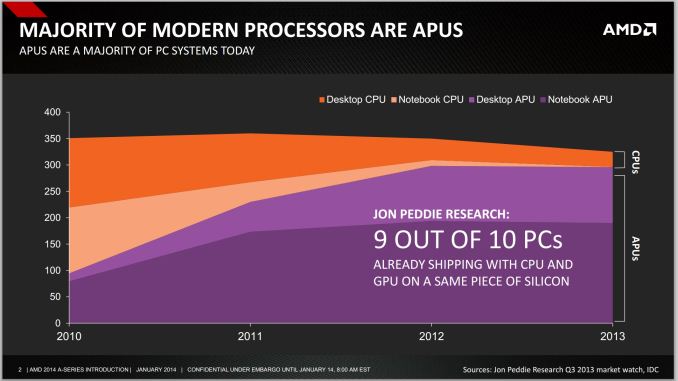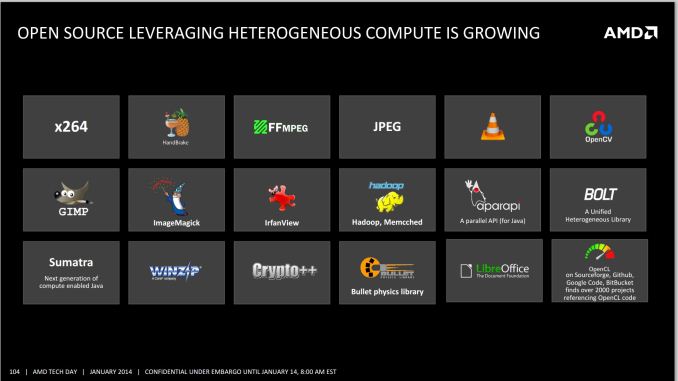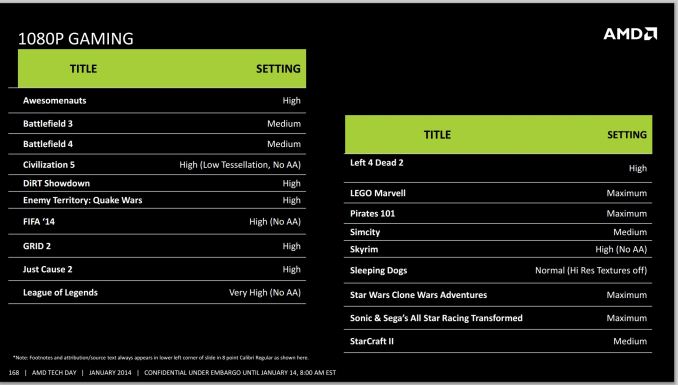AMD Kaveri Review: A8-7600 and A10-7850K Tested
by Ian Cutress & Rahul Garg on January 14, 2014 8:00 AM ESTKaveri: Aiming for 1080p30 and Compute
The numerical differences between Kaveri and Richland are easy enough to rattle off – later in the review we will be discussing these in depth – but at a high level AMD is aiming for a middle ground between the desktop model (CPU + discrete graphics) and Apple’s Mac Pro dream (offloading compute onto different discrete graphics cards) by doing the dream on a single processor. At AMD’s Kaveri tech day the following graph was thrown in front of journalists worldwide:
With Intel now on board, processor graphics is a big deal. You can argue whether or not AMD should continue to use the acronym APU instead of SoC, but the fact remains that it's tough to buy a CPU without an integrated GPU.
In the absence of vertical integration, software optimization always trails hardware availability. If you look at 2011 as the crossover year when APUs/SoCs took over the market, it's not much of a surprise that we haven't seen aggressive moves by software developers to truly leverage GPU compute. Part of the problem has been programming model, which AMD hopes to address with Kaveri and HSA. Kaveri enables a full heterogeneous unified memory architecture (hUMA), such that the integrated graphics topology can access the full breadth of memory that the CPU can, putting a 32GB enabled compute device into the hands of developers.
One of the complexities of compute is also time: getting the CPU and GPU to communicate to each other without HSA and hUMA requires an amount of overhead that is not trivial. For compute, this comes in the form of allowing the CPU and GPU to work on the same data set at the same time, effectively opening up all the compute to the same task without asynchronous calls to memory copies and expensive memory checks for coherency.
The issue AMD has with their HSA ecosystem is the need for developers to jump on board. The analogy oft cited is that on Day 1, iOS had very few apps, yet today has millions. Perhaps a small equivocation fallacy comes in here – Apple is able to manage their OS and system in its entirety, whereas AMD has to compete in the same space as non-HSA enabled products and lacks the control. Nevertheless, AMD is attempting to integrate programming tools for HSA (and OpenCL 2.0) as seamlessly as possible to all modern platforms via a HSA Instruction Layer (HSAIL). The goal is for programming languages like Java, C++ and C++ AMP, as well as common acceleration API libraries and toolkits to provide these features at little or no coding cost. This is something our resident compute guru Rahul will be looking at in further detail later on in the review.
On the gaming side, 30 FPS has been a goal for AMD’s integrated graphics solutions for a couple of generations now.
Arguably we could say that any game should be able to do 30 FPS if we turn down the settings far enough, but AMD has put at least one restriction on that: resolution. 1080p is a lofty goal to hold at 30 FPS with some of the more challenging titles of today. In our testing in this review, it was clear that users had a choice – start with a high resolution and turn the settings down, or keep the settings on medium-high and adjust the resolution. Games like BF4 and Crysis 3 are going to tax any graphics card, especially when additional DirectX 11 features come in to play (ambient occlusion, depth of field, global illumination, and bilateral filtering are some that AMD mention).













380 Comments
View All Comments
keveazy - Wednesday, January 15, 2014 - link
Compete to do heavy software and GAMING. My motherboard only costs $60. Of course I "checked". Intel is not stupid. Their 4600 is not meant for gaming and they Don't boast about it. I use a dedicated GPU to run games.AMD keeps on advertising their igpu that it can run today's games like battlefield 4 on 1080p. Yeah, on Low settings...... Even the PS4's gpu is better than that.
YuLeven - Thursday, January 16, 2014 - link
If general tasks and gaming is on stake here, I say buy a cheap Pentium G for US$65 and a HD 7770GE for US$110 (today's price at newegg). The SSD too, of course. Voilá, you have fast general tasks and a GPU that makes the A10-7850K's GPU look like a toy.just4U - Thursday, January 16, 2014 - link
Your I5 costs $200ish.. sales might get that down to 185 if your lucky.. I rarely see it though.keveazy - Saturday, January 18, 2014 - link
I bought my I5 4440 for $175 dude. you serious?Laststop311 - Wednesday, January 15, 2014 - link
the 45 watt one oe 65 watt once would make an awesome htpc loaded withh all the old school emulators and so,e mew games with controllers.JDG1980 - Wednesday, January 15, 2014 - link
Old-school emulators will work fine on almost any modern system, including one with Intel's integrated graphics.fox1986 - Wednesday, January 15, 2014 - link
Would it be possible to make a fm2 motherboard with 6 display outputs?fteoath64 - Sunday, January 19, 2014 - link
"with 6 display outputs?". Buy a Netfinity 6 port Gpu card and stick it on the PCIe X16 slot and you are set. There was one Netfinity card that had 5 miniDP ports and a DVI connector, if I am not mistaken.figus77 - Wednesday, January 15, 2014 - link
"It is interesting to note that at the lower resolutions the Iris Pro wins on most benchmarks, but when the resolution and complexity is turned up, especially in Sleeping Dogs, the Kaveri APUs are in the lead."It's simple... al low resolution and detail the raw power of the i5 crush the A10 when there is not GPU bottleneck...
duploxxx - Wednesday, January 15, 2014 - link
that could be tested inserting an equal discrete GPU on to both systems....